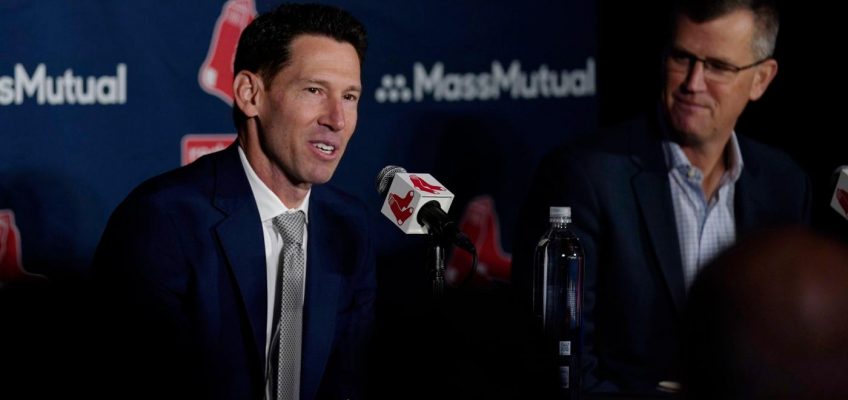When Craig Breslow joined the Chicago Cubs five years ago, he could not have envisioned his path and how his contributions with the organization would play out.
His rise from director of strategic initiatives for baseball operations to assistant general manager and vice president of pitching included meeting with right-hander Jameson Taillon last offseason to recruit the free agent to sign with the Cubs.
“But nonetheless there we found ourselves,” Breslow said this week at the GM meetings in Arizona. “I am grateful for those opportunities, but mostly for kind of that trust.”
The Boston Red Sox hired Breslow, 43, last month as their chief baseball officer. Over the course of the hiring process, he constantly talked to president of baseball operations Jed Hoyer, both to loop him in professionally and take him up on his offer to provide insight and advice during the process. Breslow also spoke with Theo Epstein a handful of times given his success in the same role with the Red Sox.
“I kind of needed to affirm my own beliefs, my own philosophies, my own vision in terms of how to structure and run an organization, so this was an incredible exercise in that,” Breslow said.
Breslow spent five of his 12 big-league seasons with the Red Sox, including winning the 2013 World Series, and his roots remained, living there with his family even while working with the Cubs. He viewed the job as the once-in-a-lifetime opportunity, one he didn’t want to pass up.
“If I had tried to wait until I was absolutely ready to dive in, it may not be there,” Breslow said. “As I’ve gone through the process, I feel both humbled by the expanse of the job but also reassured in that I am ready.”
During Breslow’s time with the Cubs in leading changes to their pitching infrastructure, he witnessed their depth and quality improve, two areas they were committed to strengthening.
“Did we did we get it perfect?” he said. “No, but we set a clear plan and steer in a clear direction and we were able to largely execute.
“I’m not sure how they’re going to replace me,” Breslow quipped. “The organization, is in great hands. … I’m excited to see how that goes from afar.”
The Cubs still are discussing how to fill Breslow’s role, Hoyer said, but they will look outside the organization and also likely promote some people.
“The truth is, honestly, Bres is probably not going to take one person to replace all of the things that he was doing,” Hoyer said, “so we’ll probably look for a multiprong approach to replace him.
“He left us in really good shape. I’m confident that the guys going forward can continue with that infrastructure and do a great job. There’s no doubt he had a big impact on all of our pitching decisions and in that regard he’s always going to be hard to replace.”
The Cubs saw important gains in homegrown arms after Breslow joined the organization in January 2019. Justin Steele’s emergence into a Cy Young Award contender along with the development and matriculation of arms with upside through their minor-league system are part of the dividends from overhauling the organization’s pitching infrastructure. After successfully harnessing ways to increase pitchers’ stuff and velocity, the Cubs must figure out how to improve command and execution system wide. Command training features a lot of uncertainty.
“I told the guys who I left behind that when they figured that out to let me know,” Breslow said, smiling. He expects the Cubs will see that area start to pay off in the next year.
The process wasn’t always smooth, especially at the onset. Although Breslow had total support from Epstein and Hoyer, it was challenging to change the culture, one that had success but hadn’t developed enough pitching. Getting everyone united and moving in the same direction can be difficult given how many people work in a front office and on a coaching staff. Breslow learned from the process and, looking back, might have approached certain things differently.
“But generally the blueprint for success is understand currently where you are, understand where you need to go and understand how you get there and have as many honest, open conversations about that as you possibly can,” Breslow said. “Because at the end of the day, if this is to work, everybody’s going to be perfectly clear on what the pathway was so trying to do anything other than be transparent and candid I don’t think is super effective.”
Hoyer commended Breslow for how he navigated the friction among personnel when it became apparent the Cubs were going to do things differently.
“With any changes, people are going to jump on board and say that’s great, and there’s people that are going to realize this probably isn’t the best place for them and it takes time and change can be hard and he was changing an infrastructure that needed to be changed,” Hoyer said. “He did a great job of that because we needed an overhaul at that point from top to bottom. Our pitching is in a much better place now because he was there.
“You’ve got to build the structures that are kind of anti-fragile and not just like if one person leaves they fall apart, and he hired a lot of really good people and those people step up and do a good job. He was very impactful in building that up.”
()


Leave a Reply